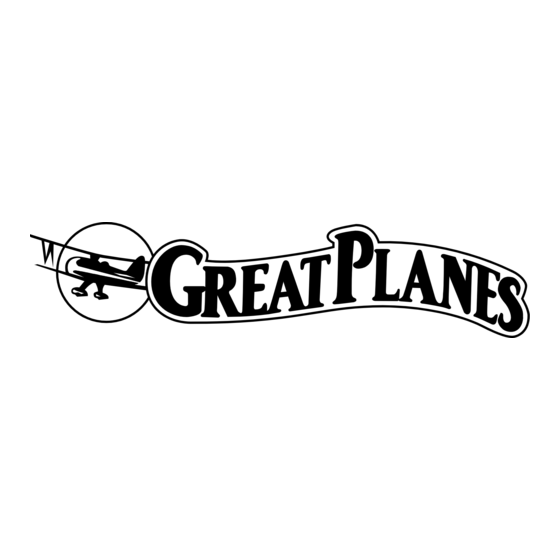GREAT PLANES J-3 ElectriCub 사용 설명서 - 페이지 14
{카테고리_이름} GREAT PLANES J-3 ElectriCub에 대한 사용 설명서을 온라인으로 검색하거나 PDF를 다운로드하세요. GREAT PLANES J-3 ElectriCub 20 페이지. Electric sport-scale arf

Propeller Installation
Prior to balancing the model install the propeller.
Balance the Model (C.G.)
More than any other factor, the C.G. (balance point) can
have the greatest effect on how a model flies, and may
determine whether or not your first flight will be
successful. If you value this model and wish to enjoy it for
many flights, DO NOT OVERLOOK THIS IMPORTANT
PROCEDURE. A model that is not properly balanced will
be unstable and possibly unflyable.
The servo tray and receiver location are used to adjust the
center of gravity (C.G.). For now, temporarily position the
battery in the battery compartment and receiver in the radio
compartment, but do not secure them in place. When setting
the C.G. (below), adjust the position of the receiver and
servo tray as needed. Remember to also reposition the
Velcro
®
and rubber band mounting to properly hold them in
place. Note: Once the Mini Cub ARF is balanced, you may
secure the receiver and glue the servo tray in place.
1. Use a felt-tip pen or 1/8" [3mm] wide tape to accurately
mark the C.G. on the bottom of the wing on both sides close
to the fuselage. The recommended C.G. is located 2-1/16"
[52mm] back from the leading edge of the wing.
This is where your model should balance for the first
flights. Later, you may wish to experiment by shifting the
C.G. up to 1/4" [6.4mm] forward or 1/4" [6.4mm] back to
change the flying characteristics. Moving the C.G. forward
may improve the smoothness and stability, but the model
may then require more speed for takeoff and make it
more difficult to slow for landing. Moving the C.G. aft
makes the model more maneuverable, but could also
cause it to become too difficult to control. In any case,
start at the recommended balance point and do not at
any time balance the model outside the specified range.
2. With the wing attached to the fuselage and all parts of
the model installed (ready-to-fly), place the model on a
Great Planes C.G. Machine
you marked.
3. If the tail drops, the model is "tail heavy" and the
battery pack and/or receiver must be shifted forward or
weight must be added to the nose to balance. If the nose
drops, the model is "nose heavy" and the battery pack
and/or receiver must be shifted aft or weight must be added
to the tail to balance. If possible, relocate the battery pack
and receiver to minimize or eliminate any additional ballast
required. Use Great Planes (GPMQ4485) "stick-on" lead if
necessary to add weight. A good place to add stick-on nose
weight is to the firewall (don't attach weight to the cowl–it is
not intended to support weight). Begin by placing
incrementally increasing amounts of weight on the bottom of
the fuse over the firewall until the model balances. Once you
have determined the amount of weight required, it can be
permanently attached. If required, tail weight may be added
under the stabilizer.
4. IMPORTANT: If you found it necessary to add any
weight, recheck the C.G. after the weight has been installed.
Balance the Model Laterally
1. With the wing level, lift the model by the motor
propeller shaft and the bottom of the fuse under the TE of
the fin. Do this several times.
2. If one wing always drops when you lift the model, it means
that side is heavy. Balance the airplane by adding weight to the
other wing tip. An airplane that has been laterally balanced will
track better in loops and other maneuvers.
At this stage the model should be in ready-to-fly condition
with all of the systems in place including the motor, landing
gear, covering and paint, and the radio system.
14
™
, or lift it at the balance point
